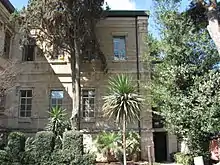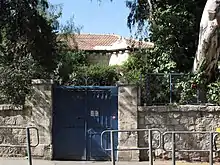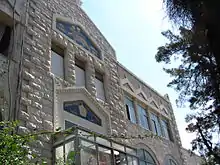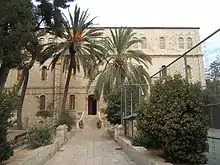Street of the Prophets
Street of the Prophets (Hebrew: רחוב הנביאים, Rehov HaNevi'im) is an east–west axis road in Jerusalem beginning outside Damascus Gate and ending at Davidka Square. Located to the north of Jaffa Road, it bisects the neighborhood of Musrara.


During its heyday in the late 19th century and early 20th century, Street of the Prophets was a favorite address for hospitals, churches, monasteries, hospices,[1] government offices, foreign consulates, and wealthy Christian, Jewish and Arab residents.
Today the street still boasts the same heterogeneous mix of residents and workers,[2] as well as schools, hospitals, churches and government offices. The elegant 19th-century architecture gives Street of the Prophets the appellation of "most beautiful street outside the Old City", while its historic buildings make it the most popular site for guided tours outside the Old City.[2]
Etymology

Street of the Prophets was established during the expansion of Jerusalem beyond the walls of the Old City in the mid-19th century.[3] In the beginning, the street did not have a name. It was known as:
- "Street of the Hospitals" — due to the many hospitals, Christian and Jewish, situated along its route;
- "Street of the Consuls" — due to the many foreign consulates that opened offices here.[3][4]
The street was officially named at the beginning of the British Mandate period by the Governor of Jerusalem, Ronald Storrs.[3] At that time, the street was paved and infrastructure for water and electricity were installed.
According to one opinion, the street was named for the prophets of Israel, many of whom prophesied in Jerusalem.[4] Another opinion holds that the street was named for the prophets of Judaism, Christianity and Islam, since the Mamluk tomb of Nabi Okasha in the nearby Zikhron Moshe neighborhood was traditionally viewed as the burial site of prophets of the three monotheistic faiths.[3]
Pre-1948 hospitals and Christian missions

Early on, Street of the Prophets was a popular address for hospitals, often run by confessional organisations. In the mid-19th century, the hospitals that were located in the Old City were forced to move due to high population density and difficult sanitary conditions. Each hospital re-established itself on Street of the Prophets to maintain its proximity to the residents still residing in the Old City.
Street of the Prophets was also home to Christian missions. The most prominent was the London Jews' Society mission headquartered at the western end of the street (now the Anglican International School campus). This 32-dunam site housed and employed hundreds of impoverished Jewish immigrants from Russia in the 1880s[5] (see below under "English Hospital"). The hospitals run by Christian missionary organizations offered free medical care to attract Jewish patients for the purposes of missionizing. This practice was decried by the rabbis of the era, who issued a cherem against Jews who used these health services. Despite rabbinical opposition, many Jews continued to turn to Christian missionary hospitals for medical care.[6]

The hospitals established on Street of the Prophets in the late 19th century and early 20th century included:
- Marienstift Children's Hospital (#29), opened in 1872 by Dr. Max Sandreczky

- Italian Hospital (#34), opened in 1919
- Meyer Rothschild Hospital (#37), the first Jewish hospital outside the Old City, built by Baron James Rothschild in 1888 and named after his father
- German Deaconess Hospital (#49, corner with Straus St.), opened in 1894. After 1948 it was taken over by Bikur Cholim Hospital as the "Ziv Building".
- Bikur Cholim Hospital (#53), built in 1910
- English Hospital (former), now Anglican School (#82). The hospital was opened in 18966 by the London Society for Promoting Christianity Among the Jews. Across the street and a bit further north is a modern hotel, built where the English Mission had opened a sanatorium in 1862.[7]
Government offices and consulates
- Pasha's House (#61), built by the Greek Orthodox Church and rented out to the Ottoman governors of Jerusalem.[8]
- The German consulate once stood beside the International Evangelical Church on the site of present-day Raoul Wallenberg Street. It was attacked by the Israeli underground when it flew a flag with a swastika in 1933,[9] and was subsequently destroyed by the underground.[10]
- The U.S. Consulate General, founded in the Old City in 1844, relocated to an address near the beginning of Street of the Prophets in the late 19th century. In 1912, it moved to its present address on Agron Street.[11]
- Ethiopian Consulate (#38-40), built by Empress Zewditu I of Ethiopia in 1928;[5] it housed that country's consulate from 1948 to 1973.[12]
Hotels

Private homes

Unlike other areas outside the Old City which were exclusively Jewish, Christian or Arab, the Street of the Prophets was a heterogeneous zone. Ottoman and, later, British officials; foreign consuls and well-to-do residents all lived here, creating a cultural and social center.[13]
Notable residents of the street include:
- "Thabor House" (#58), the home of Conrad Schick, German Protestant missionary and architect who designed and/or built several of the buildings on the street, including his own.
- Navon Bey House (#59) was the residence of Joseph Navon, a Jewish businessman and initiator of the Jaffa–Jerusalem railway.[7][8]
- Hunt residence (#64), built in 1869 by English painter William Holman Hunt.[14] Later tenants included Dr. Helena Kagan, Jerusalem's first pediatrician. Hebrew poet Rachel lived in the small white house in the courtyard in 1925 and wrote a poem inspired by a pear tree Hunt planted in the courtyard.[15]

- "Mahanaim" (34, Shivtei Yisrael Street and Street of the Prophets), built in 1885 by Johannes Frutiger, a Swiss banker, who named his home after a verse in Genesis (Gen 32:2). His family was later forced to sell the mansion; it was later occupied, in turn, by the Evelina de Rothschild School,[10] Menachem Ussishkin, director of the Jewish National Fund,[5] and Lord Herbert Plumer, High Commissioner during the Mandate period.[16] Today it houses offices of the Israeli Ministry of Education.
Religious communities

In the late 19th century, several Jewish neighborhoods were founded at the eastern end of Street of the Prophets, near Damascus Gate. Kirya Ne'emana (commonly known as Batei Nissan Beck, "Nissan Beck Houses"), was founded in 1875 for Hasidic residents.[17] In the 1880s and 1890s additional housing was built for Syrian, Iraqi, and Persian Jews.[17] Eshel Avraham was established in 1893 for Georgian and Caucasian Jews.[6] These neighborhoods were virtually abandoned during the 1929 Palestine riots and the homes taken over by Christians and Muslims.[17] The remaining Jewish residents left with the Arab takeover of East Jerusalem after 1948.[6]
Beginning in the 1880s, an Ethiopian Christian community developed around the Ethiopian Church of Debre Gannet (Mount of Paradise) located on a site in Ethiopia Street bought in 1888, just north of Street of the Prophets.[18] Under the initiative of Empress Taytu Betul, Ethiopian nobles and wealthy individuals contributed large sums of money to purchase houses on Ethiopia Street and Street of the Prophets, which belong to the community to this day.[12]
Architecture

Most of the buildings on Street of the Prophets are constructed of stone and fronted by high walls built of stone and mortar. Private-home lots are large and include garden courtyards, either in front of the building (e.g. Hunt House, Navon Bey House, Mahanaim House) or behind it (e.g. Pasha's Village). The homes are one or two stories high; public buildings do not exceed four stories.

Many public and private buildings on the western side of Street of the Prophets, from Shivtei Israel Street to Davidka Square, are built in the European style and reflect the nationality of their builders. For example, the German Deaconess Hospital and its bell tower (today the eastern wing of Bikur Cholim Hospital) are typical of churches and other public buildings in Germany. Buildings and doors along the street are decorated with religious symbols such as crosses, Stars of David, crescents, symbols of religious institutes, and Bible verses.
Several buildings were designed by architect Conrad Schick: the mission of the London Jews' Society (today the Anglican International School); parts of the German hospital,[5] and the Tabor House (today the Swedish Theological Institute) (#58), which Schick made into his own home. Schick planned the William Holman Hunt House (#64), which Hunt himself built.
The Renaissance-style Italian Hospital was designed by Antonio Barluzzi, who created several other Christian churches in Jerusalem. It was completed in 1919; today it houses the Israel Ministry of Education and Culture.[5]

In 1898, Theodor Herzl came to Jerusalem for the first time to meet with German emperor Wilhelm II, who was also visiting this city. Herzl met the emperor on an empty lot at #42 Street of the Prophets, where Wilhelm and his entourage were quartered in a tent camp.[5] Herzl's efforts to plead the Zionist cause with the emperor were unsuccessful.[19] Following the emperor's visit, the Ottoman authorities gave him the lot as a gift; Wilhelm, in turn, granted it to the German provostry, which constructed its headquarters there in 1903.[16] Today the former provostry is part of the Jerusalem ORT campus.[5]

The former Ethiopian consulate building at #38 and #40 is the sole representative of African architecture. The land for the building was purchased in 1910 by Baron von Ustinov on the directive of Empress Taytu of Ethiopia; his widow, Magdalena, sold the property and the partially finished building to Empress Zauditu in 1924.[20] The white stone structure, completed in 1928, has gabled windows decorated with bright blue and gold porcelain mosaics. The largest mosaic depicts a lion bearing a cross and flag — the symbol of the Ethiopian royal family — with the inscription in Ge'ez: "The Lion of Judah Triumphs".[12] Today the building is an apartment complex.[12]
Armenian mosaic

In 1894 a burial cave containing an ancient mosaic floor was discovered during excavation work for the construction of two houses at what is now 16-18 Street of the Prophets.[21] Known as the "bird mosaic", the floor depicts peacocks, ducks, storks, pigeons, an eagle, a partridge, and a parrot in a cage, along with branches and grape clusters, all symbols of death in early Christian art. An inscription at the top of the mosaic reads, "For the memory and salvation of all those Armenians whose name the Lord knows". Beneath a corner of the mosaic lay a natural cave containing human bones which were dated to the 5th or 6th century, indicating that the room was used as a mortuary chapel.[22] The two-story buildings, constructed by Muslims, currently house a health clinic.[21]
Military headquarters
During both world wars and the Israeli War of Independence, large buildings on the Street of the Prophets were appropriated for military use. The English Mission Hospital, for example, was used by the Ottoman army to house their wounded soldiers during World War I; in 1917, the British Mandate officials turned it into the headquarters for the 60th Division that conquered Jerusalem. The Italian Hospital headquartered the British Royal Air Force during World War II.[5]

In 1948, the eastern end of the street, forming a triangle with the Old City walls and the southern side of the neighborhood of Musrara, was part of the no man's land between Israel and Jordan.[1] The street was returned to Israel with the reunification of Jerusalem in 1967.
Urban development
In the late 1980s, a proposal was made to widen the narrow, two-lane street into a 32-meter-wide main road. The proposal met with stiff opposition from Jerusalem residents, as it called for destroying the historic garden courtyards of the buildings lining the street. An alternate plan called for laying the highway across the courtyards while retaining the outer stone walls to maintain the 19th-century look of the street. Neither plan has come to fruition.[3] In late 2009, during construction on Jaffa Road for the Jerusalem Light Rail, Egged city buses that normally traversed Jaffa Road were diverted onto Street of the Prophets. The street also sees increased traffic as an alternate route for buses traveling to northern Jerusalem neighborhoods (via Road 1) whenever Straus Street is closed due to demonstrations. In recent years, the city has granted permits for the development of high-rise, luxury apartment projects on and alongside Street of the Prophets. These projects are expected to alter the quiet, exclusive nature of the street.[2]
Modern institutions
Schools

- Anglican International School (#82)[23]
- Hadassah College Jerusalem (formerly Hadassah College of Technology) (#37)[24]
- Jerusalem ORT (#42)
- Lycée Française (French School) (#66)
Hospitals
Between 1976 and 1988, a railway coach parked a few meters east of Bikur Holim Hospital housed the national headquarters for the Yad Sarah home-care equipment lending organization.[5][25] The building at #43 Street of the Prophets still bears the organization's name.
Christian organizations

- International Evangelical Church (#55)
- St. Joseph of the Apparition Convent (#66)
- Swedish Theological Institute (#58)[26]

- Shevet Achim, an international community that brings children with congenital heart defects to the medical centers in Israel (#29)
Government offices
- Ministry of Education and Culture (Italian Hospital building)
- Ministry of Education office (Lev-Ram building)
- Ministry of Education (Mahanaim house)
Hostels
- Abraham Hostel[27]
- Palm Hostel
Memorials
- Davidka Square, at the western end of the street (corner Jaffa Road), commemorates the homemade mortar called the Davidka used during the Israeli War of Independence
- Mitzpe Tomer (Tomer Observation Post) at the eastern end of the street (corner Highway 60) commemorates the spot where, in April 2002, a traveling car bomb detonated, killing 19-year-old Israeli border policeman Mordechai Tomer
References
- "Jerusalem Strolls: Haneviim and Ethiopia St". jerusalemite.net. 2008-09-03. Retrieved 2010-07-11.
- "Street of the Prophets Plan". Sustainable Jerusalem Coalition. 2001. Retrieved 2010-07-11.
- "Ha-nevi'im Street". Jerusalem Municipality. Archived from the original on 2011-06-17. Retrieved 2010-07-11.
- Eisenberg, Ronald L. (2006). The Streets of Jerusalem: Who, What, Why. Devora Publishing Company. ISBN 1-932687-54-8.
- Bar Am, Aviva. "Rehov Hanevi'im — Around the houses". The Jerusalem Post. Archived from the original on 2010-12-16. Retrieved 2010-07-11.
- Rossoff, Dovid (1998). Where Heaven Touches Earth: Jewish life in Jerusalem from medieval times to the present. Guardian Press. ISBN 0-87306-879-3.
- Eliyahu Wager (1988). English Hospital. Illustrated guide to Jerusalem. Jerusalem: The Jerusalem Publishing House. pp. 186–187.
- Bar-Am, Aviva. "A Guide to Buildings in Jerusalem". The Jerusalem Post. Archived from the original on 2012-02-24. Retrieved 2010-07-11.
- Medoff, Rafael (Spring 2004). "An Unorthodox Rabbi on Capitol Hill: The legacy of Rabbi Baruch Rabinowitz" (PDF). Jewish Action. Archived from the original (PDF) on 2011-07-23. Retrieved 2010-07-11.
- Malka, Annette (2009-08-09). "Street of the Prophets, Jerusalem". terredisrael.com. Retrieved 2010-07-11.
- "About the Consulate". Consulate General of the United States/Jerusalem. 2009. Archived from the original on 2010-07-07. Retrieved 2010-07-11.
- "The Ethiopian Consulate". Jerusalem Municipality. 2006-02-06. Archived from the original on 2011-06-17. Retrieved 2010-07-11.
- Zaun-Goshen, Heike (2007). "Beyond the Wall - Chapters on Urban Jerusalem". The Jerusalem Post. Archived from the original on 2011-06-12. Retrieved 2010-07-11.
- Gilad, Moshe (29 August 2012). "Peeking through the highrises: Famed Jerusalem street's old architectural glories". Haaretz. Retrieved 21 June 2014.
- Green, Michael (2008-08-07). "Whose Property?". The Jerusalem Post. Retrieved 2010-07-11.
- Ginsberg, Michael Peled; Ron, Moshe (June 2004). Shattered Vessels: Memory, Identity, and Creation in the Work of David Shahar. State University of New York Press. ISBN 978-0-7914-5919-5.
- Ben-Arieh, Yehoshua (1979). עיר בראי תקופה: ירושלים החדשה בראשיתה [A City Reflected in its Times: New Jerusalem – The Beginnings] (in Hebrew). Jerusalem: Yad Izhak Ben-Zvi Publications. pp. 163–165.CS1 maint: ref=harv (link)
- Robin Twite, "Die Äthiopische Kirche – Afrika in Jerusalem", Ela Moszkowicz (trl.), in: Ariel: Eine Zeitschrift zur Kunst und Bildung in Israel, vol. 102 (1996; titled: 'Jerusalem mit 3000'), pp. 40-53, here p. 50.
- "Herzl and Zionism". Israel Ministry of Foreign Affairs. 2004-07-20. Retrieved 2010-07-15.
- Berger Holtz, Toby. The Hall Family and Ethiopia: A Century of Involvement, in: Proceedings of the 16th International Conference of Ethiopian Studies, Svein Ege, Harald Aspen, Birhanu Teferra and Shiferaw Bekele (eds.), Trondheim: Norges teknisk-naturvitenskapelige universitet / Sosialantropologisk institutt, 2009, pp. 109-117, here p. 114. ISBN 978-82-90817-27-0. "The Empress Taytu had convinced her adviser, [court-lady Welette-Iyesus (1850–1932), also known as] Katarina Hall, to persuade her son-in-law, Baron von Ustinov, to acquire property in Jerusalem near the Ethiopian Church. The land was purchased in 1910, and construction of a large building began. Baron von Ustinov … died in 1917. His widow Magdalena … inherited the land in Jerusalem and the partially completed building on it. During a trip to Jerusalem in 1924, she sold the property to the Empress Zauditu while the Empress was also visiting there. The Empress continued the construction on Ustinov's foundations. The building became the Ethiopian Consulate". (Addition in edged brackets and omissions are not in the original)
- "מסלול טיול ברחוב הנביאים בירושלים" [Tour Route on Street of the Prophets in Jerusalem]. Yair Tiyulim. 2014. Retrieved 21 June 2014.
- "Armenian Mosaic, Jerusalem". sacred-destinations.com. 2010. Retrieved 2010-07-11.
- "From the Executive". aisj.co.il. Archived from the original on 2009-05-28. Retrieved 2010-07-11.
- "History". hadassah.ac.il. Archived from the original on 2011-07-21. Retrieved 2010-07-11.
- "Photo of Yad Sarah headquarters" (PDF). Harakevet Magazine. September 1989. Retrieved 2010-07-11.
- "Swedish Theological Institute". Jerusalem Municipality. 2005-09-15. Archived from the original on 2011-06-17. Retrieved 2010-07-11.
- Vered, Ronit (6 May 2011). "Leader of the backpack". Haaretz. Retrieved 17 February 2013.
External links
- Schematic drawing of Jerusalem's streets
- Jerusalem-Christian Architecture through the Ages, Ministry of Foreign Affairs, 1 January 2020. Accessed 3 October 2020.</ref>
| Wikimedia Commons has media related to Street of Prophets, Jerusalem. |